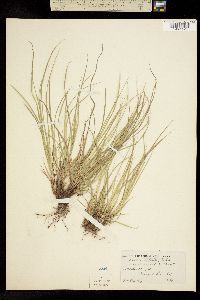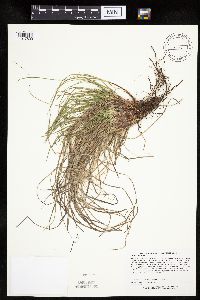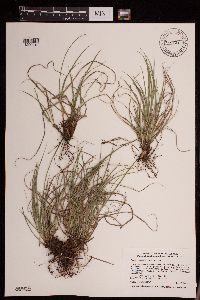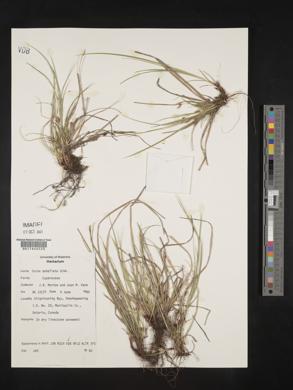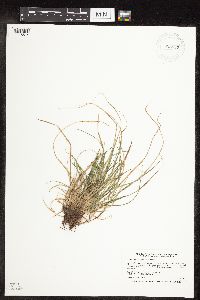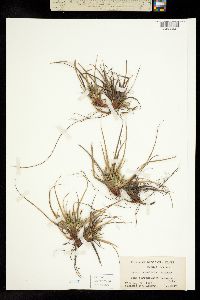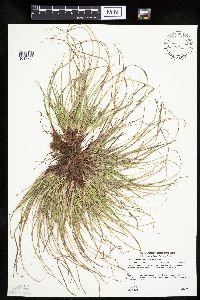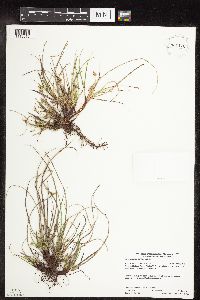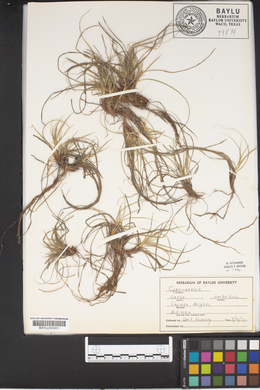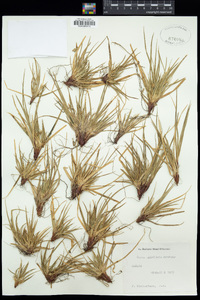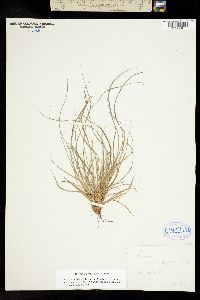Carex umbellata
|
|
|
|
Family: Cyperaceae
Parasol Sedge
[Carex umbellata f. vicina (Dewey) Wiegand, moreCarex umbellata var. brevirostris Boott, Carex umbellata var. vicina] |
Plants densely cespitose; rhizomes ascending to erect, reddish brown, 0-5 mm, stout. Culms 3-7.5(-18) cm, scabrous distally; bases (remnants of old leaves) weakly to strongly fibrous. Leaf blades pale green, greatly exceeding culms, 1-2.3(-3.8) mm wide, herbaceous, glabrous abaxially, strongly scabrous to papillose adaxially. Inflorescences with both staminate and proximal spikes; peduncles of basal spikes erect, short to elongate, slender; peduncle of staminate spikes 0.7-5.2(-12.3) mm; proximal nonbasal bracts scalelike, usually shorter than (occasionally equaling) inflorescences. Spikes: proximal pistillate spikes 2-5 (basal spikes 1-3); cauline spikes overlapping with staminate spikes, with (1-)4-12 perigynia; staminate spikes 4.6-13 × 0.7-2.2 mm. Scales: pistillate scales reddish brown with narrow white margins, ovate, 2.8-3.9 × 1.5-1.9 mm, equaling or exceeding perigynia, apex acute to acuminate; staminate scales ovate to lanceolate, 3.5-5.1 × 1.1-2.2 mm, apex obtuse to acute. Anthers 1.7-2.2 mm. Perigynia pale green to pale brown, veinless, obovoid to globose, rarely ellipsoid, obtusely trigonous in cross section, 2.2-3.2 × 1-1.4 mm; beak straight, pale green to pale brown, strongly 2-edged, 0.4-1 mm, weakly ciliate-serrulate, apical teeth 0.1-0.2 mm. Stigmas 3. Achenes brown, ellipsoid, obtusely trigonous in cross section, 1.4-1.7 × 1-1.3 mm. 2n = 30, 32. Fruiting mid Mar-mid Jul. Open, dry to mesic, circumneutral to calcareous, clayey, sandy, and rocky fields, pastures, tall-grass prairies, glades, ridges, slopes, bluffs, dunes, barrens, open deciduous and mixed woodlands, also on serpentine and basalt, often at edges of ant hills; 90-300 m; Greenland; B.C., N.B., Nfld. and Labr., N.S., Ont., P.E.I., Que., Sask.; Ala., Ark., Ga., Ill., Ind., Kans., Ky., Maine, Md., Mass., Mich., Minn., Miss., Mo., Nebr., N.J., N.Y., N.C., Ohio, Okla., Pa., R.I., Tex., W.Va., Wis. Some botanists think Carex microrhyncha should be retained as a distinct species. A revision of the C. umbellata-C. tonsa complex may reveal distinctions; until that work is done, we prefer to combine C. microrhyncha with C. umbellata.
Densely cespitose and basally fibrillose; stems 5-10(-20) cm, much surpassed and often concealed by the lvs; lvs 1-5 mm wide; staminate spike terminal, 5-10 mm, sometimes with a short pistillate spike just beneath it, the subtending bract of this pistillate spike scale-like and shorter than the staminate spike; 1-3 near-basal, short pedunculate pistillate spikes 4-10 mm generally associated with each flowering stem, ±removed from the terminal staminate spike; pistillate scales acute to short-cuspidate, about as long and wide as the greenish perigynia; perigynia 2.5-4 mm, finely hairy or glabrous, obovoid, 2-keeled above, tipped with a prominent, 2-edged, often curved, bidentate beak 0.5-1.5 mm; achene rounded-trigonous; 2n=32. Dry to moist soil, in shade or sun; Nf. to B.C., s. to Va., Ga., Mo., and Tex. (C. abdita; C. rugosperma, with a relatively long perigynium-beak; C. tonsa) Gleason, Henry A. & Cronquist, Arthur J. 1991. Manual of vascular plants of northeastern United States and adjacent Canada. lxxv + 910 pp. ©The New York Botanical Garden. All rights reserved. Used by permission. From Flora of Indiana (1940) by Charles C. Deam Infrequent in northern Indiana in dry sandy soil, usually in open woods; frequent in southeastern Indiana on crests of rocky wooded ridges and river bluffs. This and the two following species may be more common than the records indicate because they are low, inconspicuous plants, easily overlooked by collectors. In this species the longest peduncles are typically not over 8 cm in length and generally bear a staminate spike only. But on the dunes the prevalent form has elongated peduncles 12-20 cm in length which usually bear one or more pistillate spikes in addition to the staminate. This form is analogous to the plant which has been called Carex umbellata f. vicina (Dewey) Wieg. but the type specimen upon which that form is based is the long-beaked plant (C. rugosperma Mack.) so that the name cannot be applied to the Indiana plant. ...... Indiana Coefficient of Conservatism: C = 5 Wetland Indicator Status: n/a |





